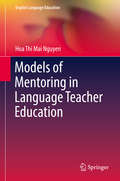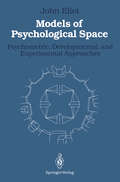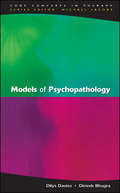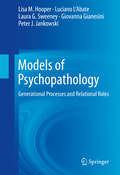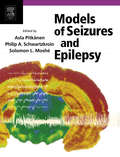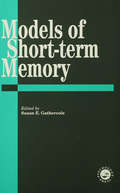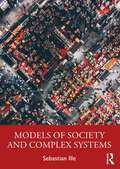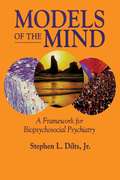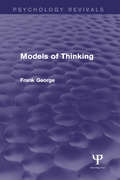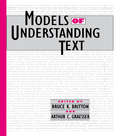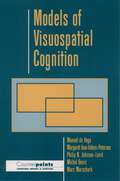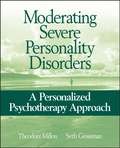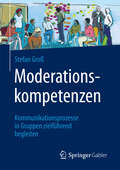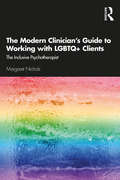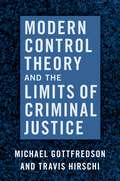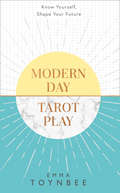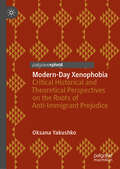- Table View
- List View
Models of Mentoring in Language Teacher Education (English Language Education #7)
by Hoa Thi NguyenThis volume examines the theoretical and practical issues related to mentoring/peer mentoring as a support and development strategy for both pre-service and in-service language teachers, and thereby offers a practical and empirical introduction to the field. A stimulating and thorough examination of mentoring and peer mentoring, integrating theory and practice as applied in language teacher education in an Asian specific context. The author discusses findings from a variety of qualitative and quantitative research studies in the light of previous research and in the context of teacher learning theories. Teachers, teacher educators, teacher trainers, supervisory coordinators and administrators will find practical advice, while the volume will be a valuable source of research information for researchers in teacher education and EFL teacher education, in particular for those who wish to employ mentoring or peer mentoring as an approach to teachers’ professional development.
Models of Psychological Space: Psychometric, Developmental, and Experimental Approaches
by John EliotModels of Psychological Space begins the reformulation of the construct of psychological space by bringing together in one volume a sampling of theoretical models from the psychometric, developmental, and experimental approaches. The author also discusses five general issues which cut across these three approaches; namely, age-related differences, sex-related differences, trainability, imagery, processing solutions, and the effect of stimulus dimensionality upon spatial performance. Models of Psychological Space provides an overview of a significant construct which has many researchable ideas, and which should be of interest to scholars from a wide range of disciplines.
Models Of Psychopathology (UK Higher Education OUP Humanities & Social Sciences Counselling and Psychotherapy)
by Dilys Davies Dinesh BhugraModels and theories of psychopathology and their associated clinical practice do not represent scientific fact so much as a variation in perspective within psychopathology itself. Several favoured models exist within any society at a given time, and as well as changing historically over time, they also differ culturally between societies. This book examines:. the similarities, differences and points of integration in the main models of psychopathology. how the theoretical conceptualizations underpinning these models are reflected in the theory and the clinical practice of different schools of psychotherapy. how various models are used in everyday practice . whether clinicians adhere to the rules of a given model or whether, in fact, there is more integration in practice than there appears to be in theoretical conceptualizations.Models of Psychopathology is aimed at advanced undergraduates and postgraduate students of clinical psychology, counselling psychology, psychotherapy and counselling. It will also be of interest to therapy students in professional training courses and experienced clinicians who want to know more about this aspect of psychotherapy.
Models of Psychopathology: Generational Processes and Relational Roles
by Lisa M. Hooper Luciano L'Abate Laura G. Sweeney Giovanna Gianesini Peter J. JankowskiThis book explores current relational models of psychopathology that undergird a great many conflicts and destructive outcomes in family and intimate relationships. These models have similar features and can be considered as a group. They are all: (1) generational; (2) relational; and (3) fundamentally reactive processes stemming from existing psychopathology.
Models of Seizures and Epilepsy
by Solomon L. Moshé Asla Pitkänen Philip A. SchwartzkroinAn understanding of mechanisms underlying seizure disorders depends critically on the insights provided by model systems. In particular with the development of cellular, molecular, and genetic investigative tools, there has been an explosion of basic epilepsy research. Models of Seizures and Epilepsy brings together, for the first time in 30 years, an overview of the most widely-used models of seizures and epilepsy. Chapters cover a broad range of experimental approaches (from in vitro to whole animal preparations), a variety of epileptiform phenomenology (including burst discharges and seizures), and suggestions for model characterization and validation, such as electrographic, morphologic, pharmacologic, and behavioral features. Experts in the field provide not only technical reviews of these models but also conceptual critiques - commenting on the strengths and limitations of these models, their relationship to clinical phenomenology, and their value in developing a better understanding and treatments. Models of Seizures and Epilepsy is a valuable, practical reference for investigators who are searching for the most appropriate laboratory models for addressing key questions in the field. It also provides an important background for physicians, fellows, and students, offering insight into the potential for advances in epilepsy research.The first comprehensive description of animal models of epilepsy since the early 1970'sComprehensive analysis of "What the models model" to guide the selection of each model, and what specific questions it will answerElegant examples of the use of novel technologies that can be applied in experimental epilepsy researchWorld expert opinions on the clinical relevance of each model
Models Of Short-Term Memory
by Susan E. GathercoleThis volume offers a collection of theoretical perspectives in the area of short-term memory. It contains overviews of models of short-term memory, with particular emphasis placed on the detailed description of the functioning of the models. The volume represents both computational approaches and theories expressed in more traditional verbal form. Models represented in the volume also cover both developmental and neuropsychological perspectives on short-term memory.; This book should appeal to active researchers in the area of memory, to graduate students, and to academics who wish to update their knowledge of this fast- developing are of research and theory. Final year undergraduates may also find this book of interest.
Models Of Short-Term Memory
by Susan E. GathercoleThis volume offers a collection of theoretical perspectives in the area of short-term memory. It contains overviews of models of short-term memory, with particular emphasis placed on the detailed description of the functioning of the models. The volume represents both computational approaches and theories expressed in more traditional verbal form. Models represented in the volume also cover both developmental and neuropsychological perspectives on short-term memory.; This book should appeal to active researchers in the area of memory, to graduate students, and to academics who wish to update their knowledge of this fast- developing are of research and theory. Final year undergraduates may also find this book of interest.
Models of Society and Complex Systems
by Sebastian IlleModels of Society and Complex Systems introduces readers to a variety of different mathematical tools used for modelling human behaviour and interactions, and the complex social dynamics that drive institutions, conflict, and coordination. What laws govern human affairs? How can we make sense of the complexity of societies and how do individual actions, characteristics, and beliefs interact? Social systems follow regularities which allow us to answer these questions using different mathematical approaches. This book emphasises both theory and application. It systematically introduces mathematical approaches, such as evolutionary and spatial game theory, social network analysis, agent-based modelling, and chaos theory. It provides readers with the necessary theoretical background of each toolset as well as the underlying intuition, while each chapter includes exercises and applications to real-world phenomena. By looking behind the surface of various social occurrences, the reader uncovers the reasons why social systems exhibit both cultural universals and at the same time a diversity of practices and norms to a degree that even surpasses biological variety, or why some riots turn into revolutions while others do not even make it into the news. This book is written for any scholar in the social sciences interested in studying and understanding human behaviour, social dynamics, and the complex systems of society. It does not expect readers to have a particular background apart from some elementary knowledge and affinity for mathematics.
Models of Society and Complex Systems
by Sebastian IlleModels of Society and Complex Systems introduces readers to a variety of different mathematical tools used for modelling human behaviour and interactions, and the complex social dynamics that drive institutions, conflict, and coordination. What laws govern human affairs? How can we make sense of the complexity of societies and how do individual actions, characteristics, and beliefs interact? Social systems follow regularities which allow us to answer these questions using different mathematical approaches. This book emphasises both theory and application. It systematically introduces mathematical approaches, such as evolutionary and spatial game theory, social network analysis, agent-based modelling, and chaos theory. It provides readers with the necessary theoretical background of each toolset as well as the underlying intuition, while each chapter includes exercises and applications to real-world phenomena. By looking behind the surface of various social occurrences, the reader uncovers the reasons why social systems exhibit both cultural universals and at the same time a diversity of practices and norms to a degree that even surpasses biological variety, or why some riots turn into revolutions while others do not even make it into the news. This book is written for any scholar in the social sciences interested in studying and understanding human behaviour, social dynamics, and the complex systems of society. It does not expect readers to have a particular background apart from some elementary knowledge and affinity for mathematics.
Models of the Mind: A Framework for Biopsychosocial Psychiatry
by Stephen L. DiltsMaking sense of such bewildering problems as hallucinations, paranoia, depression, and anxiety seems an incredible challenge, but modern psychiatry is able to bring understanding and change to many of those whose lives are impaired by psychiatric problems. This is not accomplished through the application of one dominant psychological theory, but through the integration of perspectives of many such theories in this diverse field into a befitting approach-the biopsychosocial model.Application of the biopsychosocial model will allow for understanding the patient in biological, psychological, and social terms simultaneously, and provide a holistic picture with multiple strategies for treatment.In this book, the author takes a step back from the assessment to demonstrate to the student methods of the information gathered from the patient into a clinically useful whole, essentially showing exactly how and why the psychiatrist arrives at an intervention.
Models of the Mind: A Framework for Biopsychosocial Psychiatry
by Stephen L. DiltsMaking sense of such bewildering problems as hallucinations, paranoia, depression, and anxiety seems an incredible challenge, but modern psychiatry is able to bring understanding and change to many of those whose lives are impaired by psychiatric problems. This is not accomplished through the application of one dominant psychological theory, but through the integration of perspectives of many such theories in this diverse field into a befitting approach-the biopsychosocial model.Application of the biopsychosocial model will allow for understanding the patient in biological, psychological, and social terms simultaneously, and provide a holistic picture with multiple strategies for treatment.In this book, the author takes a step back from the assessment to demonstrate to the student methods of the information gathered from the patient into a clinically useful whole, essentially showing exactly how and why the psychiatrist arrives at an intervention.
Models of Thinking (Psychology Revivals)
by Frank H. GeorgeIn this volume, originally published in 1970, an attempt is made to examine the more logical aspects of thinking, such as the ability to abstract and the manner in which concepts develop. The author describes the features that had long been regarded as central to thinking by experimental and theoretical psychologists of the time and he places more emphasis on the part played by language in cognitive activity. In the second part the author points out how such basic features of thinking as concept and hypothesis formation, inference making and the use of ordinary English are essentially things that can be carried out by a computer. His use of theories and his methods of modelling the human brain and the way it works comprise an intriguing and highly sophisticated attempt to provide an appropriate framework in which problems of thinking can be studied. Professor George was the author of several books, the best known of which at the time were The Brain as a Computer and Cybernetics and Biology. His writings covered many aspects of psychology, philosophy and logic, as well as cybernetics. At the time of original publication he was Professor of Cybernetics at Brunel University and Chairman of the Bureau of Information Science.
Models of Thinking (Psychology Revivals)
by Frank H. GeorgeIn this volume, originally published in 1970, an attempt is made to examine the more logical aspects of thinking, such as the ability to abstract and the manner in which concepts develop. The author describes the features that had long been regarded as central to thinking by experimental and theoretical psychologists of the time and he places more emphasis on the part played by language in cognitive activity. In the second part the author points out how such basic features of thinking as concept and hypothesis formation, inference making and the use of ordinary English are essentially things that can be carried out by a computer. His use of theories and his methods of modelling the human brain and the way it works comprise an intriguing and highly sophisticated attempt to provide an appropriate framework in which problems of thinking can be studied. Professor George was the author of several books, the best known of which at the time were The Brain as a Computer and Cybernetics and Biology. His writings covered many aspects of psychology, philosophy and logic, as well as cybernetics. At the time of original publication he was Professor of Cybernetics at Brunel University and Chairman of the Bureau of Information Science.
Models of Understanding Text (Cog Studies Grp of the Inst for Behavioral Research at UGA)
by Bruce K. Britton Arthur C. GraesserWhat is text understanding? It is the dynamic process of constructing coherent representations and inferences at multiple levels of text and context, within the bottleneck of a limited-capacity working memory. The field of text and discourse has advanced to the point where researchers have developed sophisticated models of comprehension, and identified the particular assumptions that underlie comprehension mechanisms in precise analytical or mathematical detail. The models offer a priori predictions about thought and behavior, not merely ad hoc descriptions of data. Indeed, the field has evolved to a mature science. The contributors to this volume collectively cover the major models of comprehension in the field of text and discourse. Other books are either narrow -- covering only a single theoretical framework -- or do not focus on systematic modeling efforts. In addition, this book focuses on deep levels of understanding rather than language codes, syntax, and other shallower levels of text analysis. As such, it provides readers with up-to-date information on current psychological models specified in quantitative or analytical detail.
Models of Understanding Text (Cog Studies Grp of the Inst for Behavioral Research at UGA)
by Bruce K. Britton Arthur C. GraesserWhat is text understanding? It is the dynamic process of constructing coherent representations and inferences at multiple levels of text and context, within the bottleneck of a limited-capacity working memory. The field of text and discourse has advanced to the point where researchers have developed sophisticated models of comprehension, and identified the particular assumptions that underlie comprehension mechanisms in precise analytical or mathematical detail. The models offer a priori predictions about thought and behavior, not merely ad hoc descriptions of data. Indeed, the field has evolved to a mature science. The contributors to this volume collectively cover the major models of comprehension in the field of text and discourse. Other books are either narrow -- covering only a single theoretical framework -- or do not focus on systematic modeling efforts. In addition, this book focuses on deep levels of understanding rather than language codes, syntax, and other shallower levels of text analysis. As such, it provides readers with up-to-date information on current psychological models specified in quantitative or analytical detail.
Models of Visuospatial Cognition (Counterpoints: Cognition, Memory, and Language)
by Manuel de Vega Margaret Jean Intons-Peterson Philip N. Johnson-Laird Michel Denis Marc MarscharkThis second volume in the Counterpoints Series, which explores issues in psychology, child development, linguistics, and neuroscience, focuses on alternative models of visual-spatial processing in human cognition. This text offers extended chapters from three of the most respected and recognized investigators in the field: Michel Denis, Margaret Intons-Peterson, and Philip Johnson-Laird. Denis considers the role of mental imagery in spatial cognition and topographical orientation; images are viewed as a form of mental representation that is similar to real-world objects. Intons-Peterson examines spatial representation in short-term, or working-memory, considering the relationship of visual-spatial processes to subjects' expectations and individual differences. Johnson-Laird approaches the issue of visual-spatial representation from a "mental models" perspective, considering the relationship of images to various cognitive events. The editors provide a historical and theoretical introduction; and a final chapter integrates the arguments of the chapters, offering ideas about new directions and new research designs.
Models Of Visuospatial Cognition
by Michel Denis Marc Marschark Manuel De Vega Margaret Jean Intons-Peterson Philip N. Johnson-LairdModen in der Hip-Hop-Szene: Eine ethnographische Studie über die Bedeutung und Dynamik von Modestrukturen (Erlebniswelten)
by Marco KrauseDiese Arbeit widmet sich dem Thema der szenespezifischen Moden. Der Kern dieser Forschungsarbeit besteht daraus, anhand einer ethnographischen Studie das szenespezifische Modephänomen im Kontext der Hip-Hop-Szene in seinen Strukturen abzubilden und dessen Facetten, Bedeutungen und Differenzierungen aufzudecken, um daran anknüpfend aufzuzeigen, welche Produkte beziehungsweise Produkteigenschaften die Szene-Mitglieder als Mode deklarieren und konsumieren und welchen Stellenwert dieses Phänomen innerhalb der Szene einnimmt. Die übergreifende Zielstellung bildet dabei die Generierung eines differenzierteren Betrachtungsansatzes des Modephänomens, welcher auf die Vergemeinschaftungsform der Hip-Hop-Szene bezogen ist und deren innere Strukturen und Facetten berücksichtigt.Der InhaltForschungsstand: Moden und Szenen • Forschungsstand: Hip-Hop-Szene • Forschungsdesign • Konsumrelevante Werte, Strukturen und Relationen in der Hip-Hop-Szene • Produktkonsum in der Hip-Hop-Szene • Moden in der Hip-Hop-SzeneDer AutorMarco Krause ist Soziologe mit Fokus auf den Bereich Konsumsoziologie und Consultant im Bereich Digital Intelligence.
Moderating Severe Personality Disorders: A Personalized Psychotherapy Approach
by Theodore Millon Seth D. GrossmanA revolutionary, personalized psychotherapy approach for the treatment of Axis II personality disorders, by renowned expert Dr. Theodore Millon Acknowledging the primacy of the whole person, Moderating Severe Personality Disorders: A Personalized Psychotherapy Approach takes into account all of the complexities of human nature - family influences, culture, neurobiological processes, unconscious memories, and so on--illustrating that no part of human nature should lie outside the scope of a clinician's regard. Part of a three book series, this book provides you with a unique combination of conceptual background and step-by-step practical advice to guide your treatment of Axis II personality disorders. Detailed case studies are provided throughout the text to illustrate the strategies of personalized psychotherapy for: Retiring/Schizoid Personality Patterns Shy/Avoidant Personality Patterns Pessimistic/Depressive Personality Patterns Aggrieved/Masochistic Personality Patterns Eccentric/Schizotypal Personality Patterns Capricious/Borderline Personality Patterns Destined to become an essential reference for trainees and professionals, this book makes a revolutionary call to return therapy to the natural reality of each patient's life, seamlessly guiding you in understanding the personality and treatment of the whole, unique, yet complex person.
Moderationskompetenzen: Kommunikationsprozesse in Gruppen zielführend begleiten
by Stefan GroßDieses Buch vermittelt kompakt und fundiert Moderationskompetenz für alle, die Besprechungen, Meetings, Workshops oder Projektrunden erfolgreich leiten wollen. Wo dies gelingt, werden Kommunikationsprozesse in Gruppen zu zielorientierten, effektiven und effizienten Ergebnissen führen. Der Autor zeigt systematisch auf, wie der Informationsaustausch in solchen Gesprächsrunden klug vorgedacht, dynamisch begleitet und wirkungsvoll gesteuert werden kann. Die Basis dafür ist ein geklärtes Rollen-, Aufgaben- und Kompetenzverständnis. Mit zielführenden Fragen, methodischen Impulsen und unterschiedlichen Formaten der Beteiligung gelingt es, gemeinsam in der Gruppe Probleme zu lösen, Konflikte zu klären, nachhaltige Ideen zu entwickeln und gute Entscheidungen zu treffen. Am Ende solcher Veranstaltungen steht ein Mehrwert für alle: zufriedene Teilnehmer, tragfähige Resultate und eine kooperative Besprechungskultur, die die Grundlage für einen dauerhaften Unternehmenserfolg bilden.
The Modern Clinician's Guide to Working with LGBTQ+ Clients: The Inclusive Psychotherapist
by Margaret NicholsThe Modern Clinician's Guide to Working with LGBTQ+ Clients is a ground-breaking resource for therapists working with LGBTQ+ clients whose identity expressions span all gender-, sex-, and relationship-diverse groups. Combining the author’s extensive clinical experience with contemporary evidence-based research, the chapters of this book explore the origins and development of sexual minority groups, going beyond lesbian women and gay men to include transgender and gender nonbinary people, kink and polyamory, bisexuality and pansexuality, and those who identify as asexual or aromantic. The text also offers in-depth coverage of clinical work with transgender, gender-nonconforming, and nonbinary clients of all ages. With a wealth of therapeutic strategies and case studies, this resource helps professionals respond to this ‘Big Tent’ community in an informed and empathetic way. Spanning sexuality, gender, relationships and age groups, The Modern Clinician's Guide to Working with LGBTQ+ Clients is an invaluable reference for psychotherapists in a broad range of clinical settings.
The Modern Clinician's Guide to Working with LGBTQ+ Clients: The Inclusive Psychotherapist
by Margaret NicholsThe Modern Clinician's Guide to Working with LGBTQ+ Clients is a ground-breaking resource for therapists working with LGBTQ+ clients whose identity expressions span all gender-, sex-, and relationship-diverse groups. Combining the author’s extensive clinical experience with contemporary evidence-based research, the chapters of this book explore the origins and development of sexual minority groups, going beyond lesbian women and gay men to include transgender and gender nonbinary people, kink and polyamory, bisexuality and pansexuality, and those who identify as asexual or aromantic. The text also offers in-depth coverage of clinical work with transgender, gender-nonconforming, and nonbinary clients of all ages. With a wealth of therapeutic strategies and case studies, this resource helps professionals respond to this ‘Big Tent’ community in an informed and empathetic way. Spanning sexuality, gender, relationships and age groups, The Modern Clinician's Guide to Working with LGBTQ+ Clients is an invaluable reference for psychotherapists in a broad range of clinical settings.
Modern Control Theory and the Limits of Criminal Justice
by Michael Gottfredson Travis HirschiIn 1990 when Michael Gottfredson and Travis Hirschi published A General Theory of Crime, now often referred to as self control theory, it quickly became among the most discussed and researched perspectives in criminology. In Modern Control Theory and the Limits of Criminal Justice, Gottfredson and Hirschi develop and extend the theory of self control advanced in their classic work. Focusing on the methodology of testing crime theory and measuring behavioral research on crime and delinquency, they critically review the evidence about self control theory. Gottfredson and Hirschi further discuss evidence about the positive consequences of higher levels of self control from education, economics, and public health, that-along with evidence from delinquency and crime-show substantial support for the theory of self control. Illustrating the theory through predictions about policing, incarceration, juvenile justice, and the connection of immigration policy to crime, this book connects self control theory to the structure and function of the criminal justice system, then applies the theory to pressing issues of public policy about delinquency and crime.
Modern Day Tarot Play: How To Use The Cards To Be A Winner At Life
by Emma ToynbeeJump from amateur straight to professional with this fast-track guide to reading the tarot.
Modern-Day Xenophobia: Critical Historical and Theoretical Perspectives on the Roots of Anti-Immigrant Prejudice
by Oksana YakushkoThis book engages the topic of xenophobia from both psychological and socio-political approaches. Recently, xenophobia as a social standpoint or social attitude has come under increased scrutiny by the public, scholars, and educators; however, few works have directly summarized current theories of xenophobia as well as articulated critical perspectives on the issue. This work provides an overview of the concept, historical factors related to its development, and a review of varied theoretical perspectives. The intertwining of psychological and sociological perspectives allows the author to present a multi-dimensional, multi-layered argument in a way which effectively prevents any attempt to apply any one single over-arching theory, and thus effectively presents the complexity of the topic at hand.
